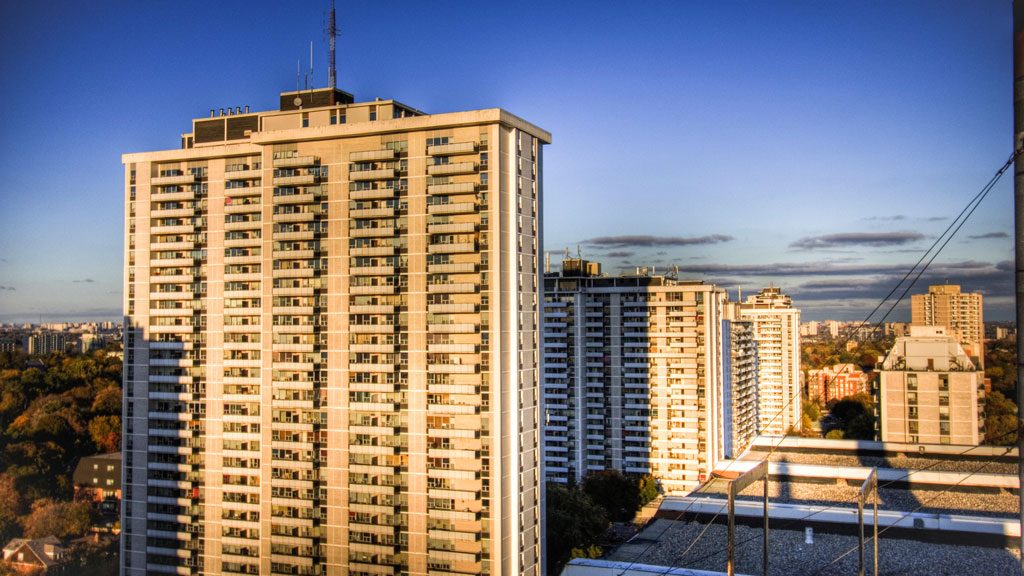An ambitious residential tower refit program launched 11 years ago in the city of Toronto has hit a wall with the cancellation of the source of some of its funding.
The Tower Renewal Project refits existing residential apartments with energy-efficient windows, insulation, heating and cooling systems and other infrastructure improvements to extend their lifecycle. The premise was first floated in a 2008 report and has been driven forward by ERA Architects and others such as the City of Toronto and the federal National Housing Strategy.
In 2016, the then Liberal government under Kathleen Wynne announced funding of $800 million over four years derived from the controversial Cap and Trade program. When the Ford government took office in July 2018, it killed Cap and Trade and as a result any funds not already advanced or approved were withdrawn.
It’s an issue which concerns evangelists for the program because there are hundreds of highrise residential towers across the Greater Toronto Area and southern Ontario all dating from the 1960s and 1970s and which are generously sized unlike today’s 400-square-foot condominiums.
“We had this amazing boom over 20 years where we basically solved the city’s housing issues and then we stopped and for 50 years we’ve used the same supply,” says Graeme Stewart, now a principal at ERA Architects. “Yet the city is three times as big.”
These buildings, for the most part, have inefficient windows and building insulation, heating and cooling systems which are at the end of their life cycle.
The buildings are mostly built with the flying form poured concrete technique which revolutionized highrise construction and led to the Toronto building boom of that era.
As such their “bones” are still strong, though some have suffered with fascia brick spalling as a result of freeze-thaw cycles and require external cladding for protection.
There’s still some money from the City of Toronto and from the National Housing Strategy so the program will continue because the need is palpable.
“The reality is these things are very capital intensive,” says Stewart, a founding director of the interdisciplinary centre for urban growth and renewal, who worked on the initial concepts back in 2008.
“The good news is that after a couple of false starts, owners are starting to see the proforma making sense.”
Aderonke Akande, City of Toronto Manager, Tower and Neighbourhood Revitalization says the city’s role is both to support renewals and to help finance some of the costs around energy efficiency and conservation.
“The program is still functioning and has been for 10 years,” she says, noting that the city facilitates “walk throughs” of about 50 buildings a year since 2008.
The numbers are huge just in the City of Toronto with more than 1,200 eight-storey plus, pre-1985 buildings. Combined they account for 240,689 units, 200,500 of which are rental units.
More than 80 per cent of these Tower Renewal buildings are privately owned with some 500,000 residents, accounting for 18 per cent of all occupied units in the City.
They also contribute to affordable housing in that rents in buildings built before 1990 are 39 per cent lower than those built later and four per cent lower than average market rent for all of Toronto.
To date, Tower Renewal has supported and encouraged 104 buildings with 21,500 units to undertake capital improvements to energy efficiency, water conservation and waste diversion while maintaining tenant comfort, she says.
The core issue for owners is risk and the program seeks to alleviate most of that risk, Stewart says, by providing the knowledge and guidance.
In that sense, he says, public housing authorities have led the way, often by necessity since they have old buildings needing upgrades.
Stewart points to electrical failures in St. James Town in Toronto as an example of what happens to building infrastructure when maintenance is deferred. Given the housing affordability issue, extending the life of 30 and 40-year-old structures is a far more cost -efficient strategy than demolition and reconstruction.
“Ten years ago when we started, we said there was a risk with 1,000 buildings and we would start to lose some and now we actually are losing some,” he says. “If we lost two, three or four buildings at once, the housing system could not support those people (displaced tenants). This is an imperative.”
Stewart says it’s not just a matter of slapping in new windows and some insulation. A big part of the program is assessing each building’s status and then planning what needs to happen.
“You can’t just put new windows in without changing lintels for example in some cases,” he says. “We may have to fix the roof and the plumbing risers. But we can give these building another 50 years. The energy program has provided a reason to deal with deferred maintenance.” The next challenge will be to mobilize the private sector, Stewart says.
There are an estimated 1,000 highrise buildings across Toronto where units are about 20 per cent less energy-efficient than the average single -family home.
Many of these towers in Scarborough, North York and Etobicoke were built when land was relatively cheap and are set on large lots with abundant green space. To encourage private owners to invest in retrofitting their towers, the program also encourages rezoning the lots to allow for other housing developments such as townhouses and also to bring in a mix of other structures to allow for commercial and retail space so that the towers aren’t isolated from a sense of community, both physical and figurative, and allow for better social interaction.










Recent Comments
comments for this post are closed